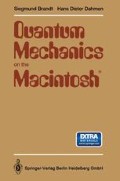Abstract
The language of quantum mechanics is needed to describe nature at the atomic or subatomic scale, e.g., the phenomena of atomic, nuclear, or particle physics. But there are many other fields of modern science and engineering in which important phenomena can be explained only by quantum mechanics, for example chemical bonds or the functioning of semiconductor circuits in computers. It is therefore very important for students of physics, chemistry, and electrical engineering to become familiar with the concepts and methods of quantum mechanics.
Access this chapter
Tax calculation will be finalised at checkout
Purchases are for personal use only
Preview
Unable to display preview. Download preview PDF.
Literature
Since in the introductory sections “Physical Concepts” we present only a very concise collection of concepts and formulae, the user of IQ is urged to study the physics topics in more detail in the textbook literature. Under the heading ‘Further Reading’ at the end of our introductory sections we refer the user to the relevant chapters in the following textbooks:
Abramowitz, M., Stegun, I.A. (1965): Handbook of Mathematical Functions (Dover Publications, New York)
Alonso, M., Finn, E.J. (1968): Fundamental University Physics, Vols. 1–3, (Addison-Wesley, Reading, MA)
Kittel, C., Knight, W.D., Ruderman, M.A., Purcell, E.M., Crawford, F.S., Wichmann, E.H., Reif, F. (1965): Berkeley Physics Course, Vols. I-IV (McGraw-Hill, New York)
Brandt, S., Dahmen, H.D. (1985): The Picture Book of Quantum Mechanics (John Wiley and Sons, New York)
Feynman, R.P., Leighton, R.B., Sands, M. (1965): The Feynman Lectures on Physics, Vols. 1–3 (Addison-Wesley, Reading, MA)
Flügge, S. (1971): Practical Quantum Mechanics, Vols. 1,2 (Springer-Verlag, Berlin, Heidelberg)
Gasiorowicz, S. (1974): Quantum Physics (John Wiley and Sons, New York)
Hecht, E., Zajac, A. (1974): Optics (Addison-Wesley, New York)
Merzbacher, E. (1970): Quantum Mechanics, (second edition) (John Wiley and Sons, New York)
Messiah, A. (1970): Quantum Mechanics, Vols. 1,2 (North-Holland Publishing Company, Amsterdam)
Schiff, L.I. (1968): Quantum Mechanics (third edition) (McGraw-Hill, New York)
Author information
Authors and Affiliations
Rights and permissions
Copyright information
© 1991 Springer Science+Business Media New York
About this chapter
Cite this chapter
Brandt, S., Dahmen, H.D. (1991). Introduction. In: Quantum Mechanics on the Macintosh®. Springer, Berlin, Heidelberg. https://doi.org/10.1007/978-3-662-25102-7_1
Download citation
DOI: https://doi.org/10.1007/978-3-662-25102-7_1
Publisher Name: Springer, Berlin, Heidelberg
Print ISBN: 978-3-540-97627-1
Online ISBN: 978-3-662-25102-7
eBook Packages: Springer Book Archive

